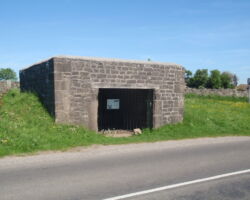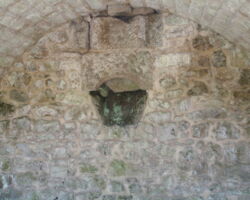Winster Ore House
Standing beside the B5056 just near to The Miner’s Standard inn, this is the best preserved Lead Ore House in the Peak District. It was used by local lead miners for keeping their hard won lead ore safe. The smaller mine owners ‘banked’ their lead by using the chute at the back to deposit the lead ore at any time and the roof is vaulted for additional security.
Large doors at the front have been replaced by a grill so that the chute and vaulted interior can be seen.
The narrow field opposite the Ore House is documented as being a rope walk.
The Peak District Authority information board tells us –
Years ago local miners would use this building like a modern nightsafe in a bank. But it was for keeping safe lead ore, not money! You are looking at the best preserved Ore House in the Peak. It had a chute for depositing the lead ore at any time, and a vaulted roof for security.
The search for lead began with the Romans. In the Middle Ages the ancient mining laws were strictly enforced by the Barmote Court.This still meets – though today it is for ceremonial rather than practical reasons.The commonest lead ore is called galena – lead sulphide – a silver-coloured mineral. It is often found with barytes, fluorite, and calcite.
This would appear to be in dispute according to Steve Thompson who writes –
All the documentary evidence (and I have explored a great deal) indicates that the ore was stored at the mine site, and when a sufficient quantity had been raised the Barmaster or Deputy Barmaster would go to the mine to measure the ore and take the proportion of duty ore, called Lot or Lott. This was traditionally every thirteenth dish, although the proportion did vary over time. Once measured the ore could be sold by the mine owner, and the duty ore would be sold by the Barmaster. I cannot imagine that the smaller mine owners would happily chuck their ore down a chute into some kind of communal storage as is suggested…
Ore houses used by the mine owners for storage of their ore would have been built at the mine, there is a documentary record of Benjamin Wyatt building an ore house at Watergrove Mine in the 1780s. Jim Rieuwerts’ book “Glossary of Derbyshire Led Mining Terms” contains this definition:
“ORE HOUSE, ORE COE A small building, similar to a coe, where ore was stored awaiting measurement by the Barmaster or his deputy. Ore houses were very common and were built at the mines, at premises owned by ore buyers and/or smelters and also, as at Winster Moor, to contain the Duty ore.”
Recent documentary evidence has confirmed that the Winster ore house was a Lot or Lott ore house, used by the Barmaster to store the Duty ore. According to Lynn Willies “It would have been convenient for the mid-late 18 century Barmasters (Roberts, father and, later, son), who, I think, lived just down the road in the cottages below the Miners’ Standard.”




